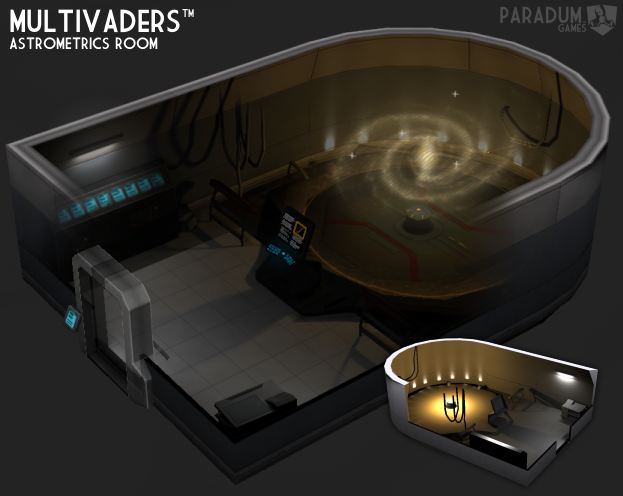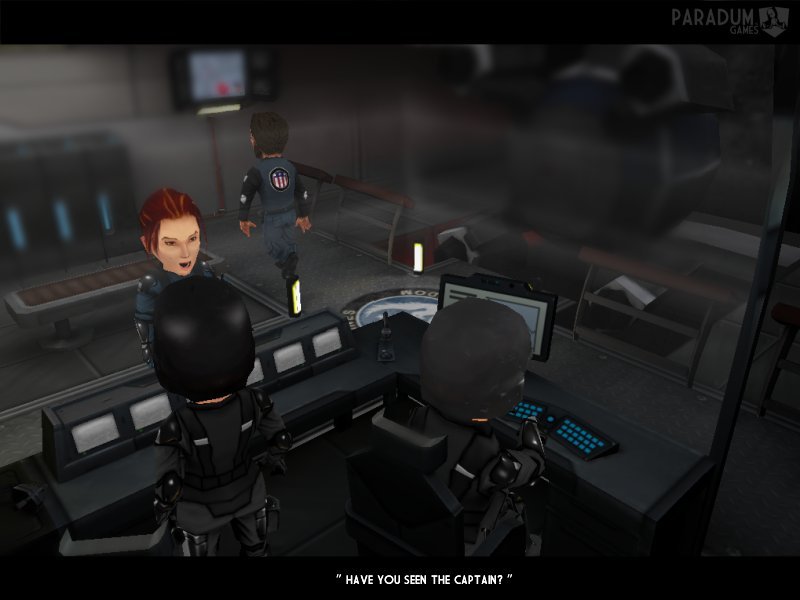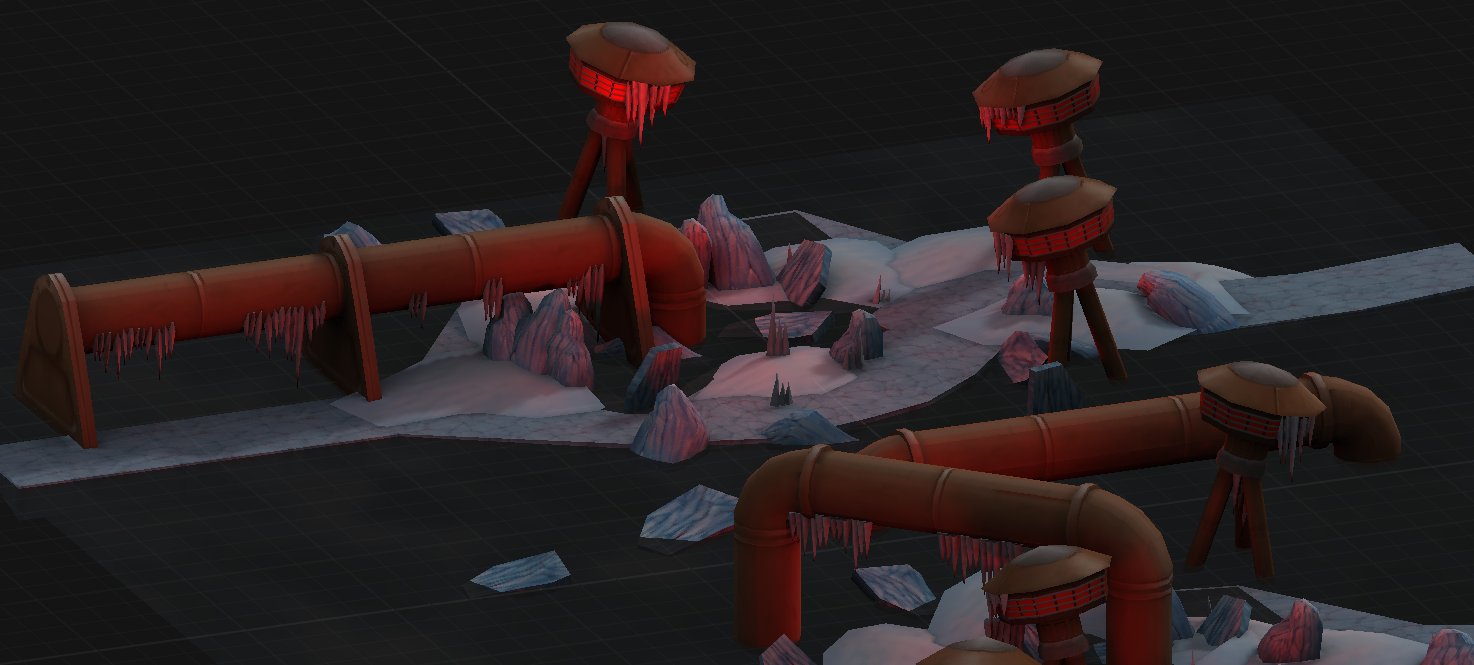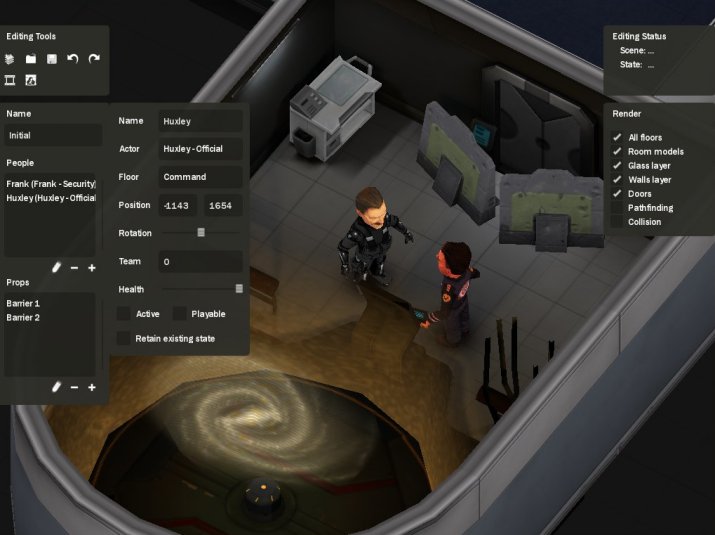Multivaders - The original concept
Retro gravitational shooter
"Multivaders" began as an experiment with Newtonian gravity simulations back in 2003 before introducing aspects of classic games such as Lander, Space Invaders and Combat. Inspired by the story of Activision's Battlezone, the narrative was loosely set in the midst of a cold-war-space-era-conflict between the USA and Soviets. Gameplay saw players battling online for control of various planets and moons around a 2D representation of the solar system, complete with working gravity and orbital mechanics.
Nudge
Back when the development of Multivaders began, it was common practice for game developers to create their own game engines, and this was no exception. The game was powered by the first iteration of my custom engine, which I named Nudge. Although the engine was not particularly groundbreaking or powerful, it provided a core set of features that streamlined the development. This included file handling, scene, mesh, and texture management, and an OpenGL powered shader-based renderer.
Though many of these features were not required in the development of a 2D top-down shooter, the physics simulation engine and the netcode systems were heavily utilized to create the game. These systems were critical in the creation of the game's realistic gravity and orbital mechanics, as well as the game's fast-paced multiplayer functionality.
Despite the challenges and time that came with creating a custom engine, it allowed me to have complete control over the development process and tailor the game to my exact specifications. This was, after-all, back before the days of Unreal Engine and Unity. Most pre-existing options were focused around first person shooters and it could be difficult to adapt to games outside that scope.
The sequel
Released as a free download, the game was relatively popular for it's time with servers being constantly populated through the day. It was featured here and there on some of the bigger gaming sites back then and was part of Gamespy's initial independent development series. I knew that I wanted to expand on the game and make something bigger and bolder, and so "Multivaders 2" was born.
The initial plan was to stick with the game's current formula - fast paced, gravity-centric 2D space battles - but add a new layer of depth in the way of ship and planet-based third person combat. No longer limited to capturing planets and moons, Multivaders 2 would see players dock with space stations, storm asteroid mining camps and capture remote research bases.
It was around this time that Gears of War released for Xbox 360 and Killzone Liberation appeared on PSP. I loved both games and it felt like a natural progression to inplement a cover-based shooter aspect to Multivaders. The game now had several artists creating some amazing characters and environments and we set to work building a prototype that would pull the ideas together and present the concept of the game.
As the design of the new gameplay elements progressed, a new psuedo-3D/isometric 3rd person viewpoint was utilised when the player controlled characters in a station, ship or building, and elements such as usable doors, consoles and computers were integrated.
Scope creep
It was about this time that feature-creep set in and Multivaders first stalled. We'd managed to pull together a demo dubbed 'Valentines Massacre'. Set on Sagan station, a fully-realised research institute on the moon, the level saw players cooperatively fight off waves of invading enemies named The Scavengers. It was a fun, action-packed little slice of gameplay that demonstrated much of the art and engine features we'd worked on over the past year or so.
We were geared up to release on Valentines day, 2008, but something didn't feel right with the demo. It was fun, but it was also very limited in scope. I'm a bit of a perfectionist and had grand visions for the project, and worried it might dissuade people from playing the game if they got their hands on the current version that I considered to be a bit dull. I felt like the gameplay ideas I'd implemented didn't quite match the fantastic art and environments we'd created.
The game also currently lacked the spaceships and 2D space-based combat from the first game. I'd prototyped it in separate builds with placeholder art, and it was fun to blast off of a planet, dock at a mothership and run around inside (while being able to see players and AI on the planet below). It had, however, taken us a year to design and build the moon environment. We would need two or three more of these areas (as well as ship interiors) if there was to be space flight.
I decided to delay the release and we began to build environments for various locations around the solar system (initially Jupiter). From an icey water-mining colony on Europa to the volcanic peaks of a research facility on Io, I started to add more and more to the backlog of art the artists were cranking through. All without the payoff of their amazing work being shown off to the public.
In hindsight, this was the first big mistake I made on the project and the point that the story began to creep in and railroad the project.
Heavy narrative
The grand vision for Multivaders 2 was a story-based campaign. With prototypes existing that pulled together the ability to fly around and explore, fight and conquer in a vast universe (both in ship and on foot) it felt natural to tie this all together with an arcing narrative. It also seemed to be the answer for the 'dull' gameplay. I tend to play big plot-heavy games and it seemed that some kind of central storyline would give the player a reason for running around these environments and exploring, collecting and shooting things.
This was also around the time that 'episodic' gaming had begun to appear. Games such as Half Life 2, SiN and the like had introduced their content in small slices and this felt like a great model to try to apply to Multivaders (and also gave hope to cutting up the game into developable chunks we could actually finish).
The decision was made to pull everything together into Multivaders: Season 1. This would introduce The Scavengers into a wider plot that presented a ship, The Vanguard and the crew. Players would follow the adventures of Captain Huxley as he'd steer his subordinates through an alien invasion, scupper plans from a corrupt Earth-Government and build a team on a ship that the players would recognise and call home.
The main artist of the team, Carl Brännström, began to build swathes of amazing looking characters, computer consoles and props to populate the rooms and hallways of the ship. At the same time, I began to add features to Nudge (now in it's third iteration) that allowed players to easily design and build huge environments. Like the game, the editor was fully multiplayer and allowed mutiple people to collaborate and build ships, stations and bases that they could fly between.
The scope of the engine also expanded to accomodate this 'seasonal' aspect into the development workflow. We now needed some kind of persistent, expandable universe to set the story in. There would need to be landmark planets to visit and explore and iconic locations to integrate into gameplay and narrative. Building such a huge universe felt like a daunting task and we needed a way to realistically achieve this.
Games like Little Big Planet had recently released and introduced the concept of vast 'User created content' and this felt like an interesting avenue to explore. It would be much easier, afterall, to create a huge, believable universe if we had armies of players creating planets, space stations and colonies.
User content
We'd now been working on the game for around two years. Everyone had cranked away at features and art but we still had very little to show for all the hard work everyone had put into the game. There were promo posts on forums and small feature-demo videos but we still didn't have any kind of concrete 'demo' of the game in its current scope.
Carl received an amazing job offer and left to work on the (now-hit) game Magicka that there was no possibility of turning down. I had also since moved countries and was snowed under with work at my real-life job. Limited by what I could do, Multivaders hit a lull in its development and user-created content felt more important than ever.
Restricted by time, I'd decided to focus on adding features to Nudge 4 that were heavily based around customisation and user content. If players were going to be creating the universe, they needed some pretty fancy tools to help do it.
Multivaders now had complex character customisation and progression. Players could build outfits, give their ensemble casts scars, tattoos and customised clothing and set up stats such as speed, stamina and strength. Complex environments could be pulled together and populated around solar systems that could be navigated via fully-functioning ships and shuttles. Episodic stories could be drafted and developed using a visual, drag-drop scripting system with no programming-knowledge needed (and all of this years before Unreal Engine's blueprinting system). There were editors for creating cutscenes, tools for lipsyncing facial animation to audio. It was basically a complete toolkit for creating your own sci-fi adventures.
But there was still no game to play, no story to experience and no demo to show off these features. Because Multivaders was a passion project of mine with no budget, many of the artists had needed to move on to real, paying gigs. Though there was a huge array of existing artwork, I'd set the bar for the game so high that I felt like it needed so much more than we had.
I'd just taken too long and set the scope of an indie-game so unrealistically large.
Democritisation of Games Development
This also led to the nail in the coffin for Multivaders in its current state. It had taken years to develop the tools and systems necessary for the game. In that time Unreal Engine had since progressed to it's third version and offered lots of features that made generic game development much easier. Alternatives such as Unity had also appeared and advanced to a state that made them viable alternatives.
While Nudge had some pretty unique and innovative features when it came to editoring and content creation, these engines had much bigger teams behind them and offered a much higher fidelity when it came to graphical rendering. Nudge was still pre-baked, non real-time lighting for environments with very, very basic skeletal animation for characters.
Back to a hobby
I decided to end active development of Multivaders 2 as a professional game around 2012, six years after it had first started. Unreal Engine 4 had released and featured things like Blueprints and real-time lighting and the Indie games development scene had progressed and become much more refined and professional.
I still work on the game here and there. It has since been moved to Unreal Engine 4 (though many of the editing tools just aren't really needed or aren't achievable in another engine). The story has since gone through many iterations (The Scavengers are long-gone, for example) and I'm slowly working on building some kind of smaller-scoped adventure game out of the assets I do still have.
Looking back, I realise that I had set the scope of an indie game unrealistically high. The development of Multivaders took years, and it was difficult to maintain momentum with no budget and a small, talented team. I had to learn the hard way that sometimes, it's better to start small and build from there, especially when working on passion projects.
Despite its shortcomings, Multivaders taught me valuable lessons about game design, development, and scope management. I'm grateful for all the amazing work that others created for the project and hope that I can at least do them proud and release it as some kind of finished game some day.
So, that's the story so far. I hope you enjoyed reading about its origins and evolution. While development isn't as rapid as it used to be, keep an eye out on this site for more updates on its progression.
Multivaders

Part of the 'Multivaders' series.
A personal video-games development project, spanning 13 years.
Who I am
I'm Blake and I like to tinker with things and make stuff. When I'm not programming or developing random systems, I'm playing with electronics, doodling bits of art, 3D modelling or sculpting and painting things or nerding out watching sci-fi or horror TV.
From 2001 I worked in the games industry, eventually specialising in tools to aid in the development of video games and their engines. In 2011 I left the industry and teamed up with a few other talented composers to utilise my knowledge to help build the company 'Spitfire Audio'.
I also periodically compose soundtracks for video-games and have worked on titles such as The Stanley Parable, Portal Knights, Lost in Random as well as a few random projects such as trailer for Terraria and Minecraft and the like. You've probably also heard my music in random TV commercials at some point.
What I'm using to make games
Nowadays I tend to utilise Unreal Engine 5. I use a mixture of (mostly) C++ (Visual Studio 2022, Rider) and Blueprints.
I work with Autodesk's 3D Studio Max to generate the art required, and Adobe Photoshop or Paintshop Pro 6 for texturing. I also dabble with Allegorithmic's Substance Designer/Painter for more realistic texturing work.
I tend to generate tools in Python, C++ or NodeJS depending on what's needed.
Audio-wise, I still use Reaper, Cool Edit Pro and FL Studio to generate sounds and music respectively.

















